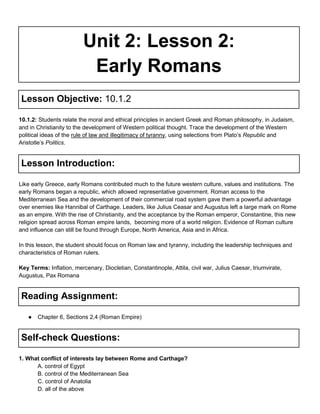
Lesson 2.2
- 1. Unit 2: Lesson 2: Early Romans Lesson Objective: 10.1.2 10.1.2: Students relate the moral and ethical principles in ancient Greek and Roman philosophy, in Judaism, and in Christianity to the development of Western political thought. Trace the development of the Western political ideas of the rule of law and illegitimacy of tyranny, using selections from Plato’s Republic and Aristotle’s Politics. Lesson Introduction: Like early Greece, early Romans contributed much to the future western culture, values and institutions. The early Romans began a republic, which allowed representative government. Roman access to the Mediterranean Sea and the development of their commercial road system gave them a powerful advantage over enemies like Hannibal of Carthage. Leaders, like Julius Ceasar and Augustus left a large mark on Rome as an empire. With the rise of Christianity, and the acceptance by the Roman emperor, Constantine, this new religion spread across Roman empire lands, becoming more of a world religion. Evidence of Roman culture and influence can still be found through Europe, North America, Asia and in Africa. In this lesson, the student should focus on Roman law and tyranny, including the leadership techniques and characteristics of Roman rulers. Key Terms: Inflation, mercenary, Diocletian, Constantinople, Attila, civil war, Julius Caesar, triumvirate, Augustus, Pax Romana Reading Assignment: ● Chapter 6, Sections 2,4 (Roman Empire) Self-check Questions: 1. What conflict of interests lay between Rome and Carthage? A. control of Egypt B. control of the Mediterranean Sea C. control of Anatolia D. all of the above
- 2. 2. As a result of 207 years of Pax Romana, the Roman Empire ________________. A. experienced continuing hostilities among neighboring regions B. survived invasions from barbarian tribes C. shrank in size and wealth D. experienced peace and prosperity 3. Why did the Roman army need to use mercenaries? A. Discipline and loyalty of Roman troops collapsed B. Soldiers became loyal to their own generals rather than the empire C. Roman were no longer willing to die for their country D. All of the above are true about mercenaries 4. What are two things Diocletian did to try to slow the decline of the Empire? A. Doubled the size of the army to protect the borders B.fixed prices C.tried to eliminate the emperor D.A and B 5. Inflation is A. significant rise in the value of money combined with a rise in prices B.significant rise in the value of money combined with a drop in prices C.significant drop in the value of money combined with a drop in prices D.significant drop in the value of money combined with a rise in prices Application Assignments: Write a 6 paragraph (including introduction and conclusion paragraph) compare and contrast essay about Greece and Rome. Include two comparisons and two differences. Choose between their political beliefs, economy, military, philosophy and/or leadership characteristics. Make sure to mention the influence Greece and Rome had on political systems, like the U.S. Constitution. Speedback Questions: 1. Which of the following was NOT something that Diocletian accomplished? A. Became the first to be declared Pope and Emperor B. Doubled the military size C. Restored the empire’s prestige D. Divided the empire into the East and West for more efficient rule 2. Rome’s military forces were called A. Plebeians B. Legions C. Phalanx D. Aqueducts 3. Which emperor divided the empire in Greek-speaking East and Latin-speaking West? A. Diocletian B. Paul C. Julius Caesar D. Peter 4. Which was the period of peace and prosperity that lasted 207 years in Rome?
- 3. A. Age of Reason B. Peace Period C. Pax Romana D. Roman Era of Justice and Peace 5. The triumvirate of Julius Caesar, Crassus, and Pompey ruled Rome for 10 years before __________________. A. Caesar disbanded his legions in Gaul B. Caesar and Pompey clashed and west to war C. Crassus demanded that Caesar not cross the Rubicon D. the senate appointed Pompey dictator 6. Why did Hannibal take the invasion route he did to conquer Rome? A. He had to pick up his elephants in Spain B. The calvary were waiting for Hannibal in Gaul C. He wanted to take the Romans by surprise D. All of the above are true Final Exam Questions: 1. The Jewish Diaspora refers to ________________. A. the destruction of the Temple in 70 AD B. the years the Jews were slaves in Egypt C. Jerusalem D. the forced dispersal of Jews 2. The emperor’s purpose for dividing the Roman Empire was _________________. A. to decrease the authority of the Senate B. to protect the west from Greek influences C. to make control of the Empire more efficient D. to separate groups whose conflicts threatened unity © 2013 Cassidy Baker
